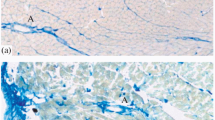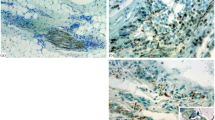Summary
The organisation of the skin and the ventral atrial epithelium of the lancelet was investigated with the electron microscope. The cuboid or columnar epithelial cells of the epidermis are not connected by desmosomes, which, however, are possibly substituted by especially constructed lateral interdigitations. The apical cellular surface is studded with microvilli, the fine structure of which suggests that they have considerable structural stability. The microvilli are covered by an electrondense layer of mucopolysaccharides. There is no cuticle on top of the epidermal cells, as described by many older light microscopists. Lowered into the surface are several urn-like depressions filled with mucins. The whole cellular periphery is densely packed with bundles of tonofilaments, forming a peculiar filamentous system at the base of the cells, which corresponds to the basal striated zone ofJoseph (1900). As a granular reticulum is lacking, it is suggested that in the well developed golgi apparatus the secretory product (mucins, presumably rich in carbohydrates) is not only concentrated for package, but also synthetized. The pigment cells of the epidermis carry a cilium.
The huge stratum of collagen fibres consists of regularly ordered layers. It is produced by fibroblasts in whose cytoplasm precursors of the collagen fibres can be found.
Under the ventral squamous epithelium of the atrium and the epidermal cells groups of nerve terminals, containing synaptic vesicles, are interspersed, which presumably represent mechanoreceptors.
Zusammenfassung
Der Aufbau der Haut und des ventralen Atrialepithels des Lanzettfischchens (Branchiostoma lanceolatum) wurde elektronenmikroskopisch untersucht. Die Zellen der einschichtigen Epidermis, die nicht durch Desmosomen untereinander verbunden sind, tragen an ihrer Oberfläche zahlreiche, durch eine Innenstruktur verstärkte Mikrovilli, über denen eine feine massendichte Schicht von Mucopolysacchariden liegt. Eine Kutikula ist nicht ausgebildet. In die Oberfläche der Epidermiszellen sind besondere urnenförmige, mit Muzinen gefüllte Gebilde eingesenkt. Die gesamte Zellperipherie ist mit Tonofilamentbündeln gefüllt, die an der Zellbasis ein besonderes Maschenwerk aufbauen, das der basalen gestreiften ZoneJosephs (1900) entspricht. In dem gut entwickeltem Golgiapparat werden die Mucopolysaccharide, die wahrscheinlich besonders reich an Karbohydraten sind, vermutlich nicht nur konzentriert und verpackt, sondern auch synthetisiert, da ein granuläres Retikulum fehlt. Die Pigmentzellen der Epidermis besitzen ein Zilium.
Die mächtige, regelmäßig aufgebaute Kollagenfaserschicht der Dermis wird von Fibroblasten gebildet, in deren Zytoplasma feine Fibrillen angetroffen werden, vermutlich Vorstufen der Kollagenfasern.
Unter den ventralen Plattenepithelzellen des Atriums und unter der Epidermis wurden Gruppen von Nervenendigungen gefunden, die synaptische Bläschen enthalten. Es handelt sich wahrscheinlich um Mechanorezeptoren.
Similar content being viewed by others
Literatur
Andrew, W.: Textbook of comparative Histology. New York: Oxford University Press 1959.
Franz, V.: Haut, Sinnesorgane und Nervensystem der Akranier Jena. Z. Med. Naturw.59, 402–525 (1923).
Joseph, H.: Beiträge zur Histologie des Amphioxus. Arb. zool. Inst. Wien12, 99–132 (1900).
—: Einige anatomische und histologische Notizen über Amphioxus. Arb. zool. Inst. Wien13, 125–154 (1901).
-Zur Beurteilung gewisser granulärer Einschlüsse des Protoplasmas. Anat. Anz., Erg.-Heft Bd. 15. Verh. Anat. Ges. 18. Verslg Jena 1904, 105–112.
Krause, R.: Mikroskopische Anatomie der Wirbeltiere in Einzeldarstellungen, Bd. 3 u. 4. Berlin: W. de Gruyter & Co. 1923.
Kurtz, S. M.: The salivary glands. In: Electron microscopic anatomy, ed. byS. M. Kurtz, p. 97–122. New York and London: Academic Press 1964.
Langerhans, P.: Zur Anatomie des Amphioxus lanceolatus. Arch. mikr. Anat.12, 290–342 (1876).
Olsson, R.: The skin of amphioxus. Z. Zellforsch.54, 90–104 (1961).
Palade, G. E.: A small particulate component of the cytoplasm. In: Frontiers in cytology, ed. byS. Palay, p. 283–304. New Haven: Yale University Press 1958.
Palay, S. L.: The morphology of secretion. In: Frontiers in cytology, ed. byS. Palay, p. 305–342. New Haven: Yale University Press 1958.
Porter, K. R., andG. D. Pappas: Collagen formation by fibroblasts of the chick embryo dermis. J. biophys. biochem. Cytol.5, 153–166 (1959).
Rabl, H.: Integument. In: Handbuch der vergleichenden Anatomie der Wirbeltiere (Hrsg.Bolk-Göppert-Kallius-Lubosch), Bd. 1, S. 271–374. Berlin: Urban & Schwarzenberg 1931.
Remane, A.: Einführung in die Tierwelt der Nord- und Ostsee, Bd.I. Leipzig 1940.
Rolph, W.: Untersuchungen über den Bau des Amphioxus lanceolatus. Morph. Jb.2, 86–164 (1876).
Schneider, K. C.: Histologisches Praktikum der Tiere, S. 370–400. Jena: Gustav Fischer 1908.
Sedar, A. W.: Stomach and intestinal mucosa. In: Electron microscopic anatomy, ed. byS. M. Kurtz, p. 123–148. New York and London: Academic Press 1964.
Studnička, F. K.: Über die Struktur der sog. Kutikula und die Bildung derselben aus den interzellulären Verbindungen in der Epidermis. S.-B. Böhm. Ges. Wiss. Prag 1897, S. 1–11. Zit. nachOlsson 1961.
Wassermann, F.: Fibrillogenesis in the regenerating rat tendon with special reference to growth and composition of the collagenous fibril. Amer. J. Anat.94, 399–438 (1954).
Weel, P. B. v.: Die Ernährungsbiologie von Amphioxus lanceolatus. Pubbl. Staz. zool. Napoli16, 221–272 (1937).
Weiss, P. A.: Structure as the coordinating principle in the life of the cell. Proc. of the R. A. Welch Foundation conferences on chemical research. V. Molecular structure and biochemical reactions, p. 5–31. 1961.
Wolff, G.: Die Cuticula der Wirbeltierepidermis Jena. Z. Med. Naturw.23, 367–384 (1889).
Zeigel, R. F., andA. J. Dalton: Speculations based on the morphology of the golgi systems in several types of protein-secreting cells. J. Cell Biol.15, 45–54 (1962).
Author information
Authors and Affiliations
Additional information
Herrn Prof. Dr.A. Remane zum 70. Geburtstag gewidmet.
Mit dankenswerter Unterstützung durch die Deutsche Forschungsgemeinschaft.
Rights and permissions
About this article
Cite this article
Welsch, U. Beobachtungen über die Feinstruktur der Haut und des äußeren Atrialepithels vonBranchiostoma lanceolatum Pall. . Z.Zellforsch 88, 565–575 (1968). https://doi.org/10.1007/BF00571801
Received:
Issue Date:
DOI: https://doi.org/10.1007/BF00571801




